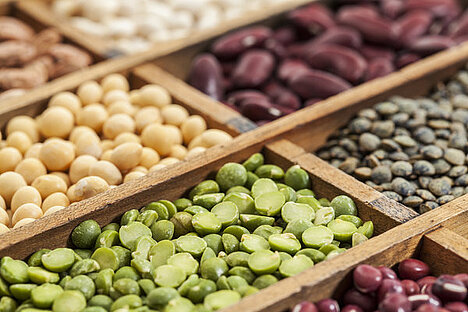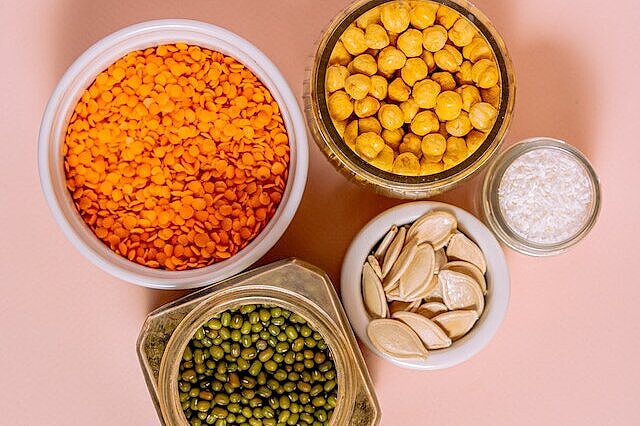Pulses

Pulses are a group of plants that produce seeds in pods. They include peas, beans, lentils and chickpeas, for example. Pulses are rich in vegetable protein, fiber, vitamins and minerals. But are they also good for dogs? In this article, you can find out more about the advantages and disadvantages of pulses for your four-legged friend.
Benefits of legumes for dogs
Legumes can have several benefits for your dog's health and well-being. Here are some of them:
- Legumes can be a good addition to a meat-based diet as they provide valuable plant-based proteins. Proteins are important for your dog's muscle building, immune system and cell function.
- Legumes are high in fiber, which can aid digestion and increase satiety. This can help control your dog's weight and prevent blood sugar fluctuations.
- Legumes are a source of vitamins and minerals such as folic acid, iron, zinc and magnesium. These nutrients support your dog's blood formation, metabolism and nerve function.
- Legumes can also contain antioxidants that can fight free radicals and prevent cell damage. Antioxidants can reduce the risk of chronic diseases such as cancer or arthritis.
Disadvantages of legumes for dogs
Legumes are not suitable for every dog. They can also have some disadvantages that you should be aware of. Here are some of them:
- Legumes can cause bloating and digestive discomfort, especially if your dog isn't used to them. This is because legumes contain hard-to-digest carbohydrates that are fermented by bacteria in the gut. This can lead to gas formation and cramps.
- Legumes can also trigger allergies or intolerances if your dog is sensitive to them. This can manifest itself in skin rashes, itching, diarrhea or vomiting.
- Legumes can also bind or inhibit certain nutrients that your dog needs. For example, they can impair the absorption of zinc or iron, which are important for the immune system and blood formation. They can also contain phytic acid, which can reduce the availability of calcium or magnesium. This can lead to deficiency symptoms or bone weakness.
How to prepare pulses for your dog
If you want to feed your dog legumes, you should follow some tips to avoid potential problems. Here are some of them:
- Choose high-quality legumes that are organic or from trusted sources. Avoid pulses with additives or preservatives.
- Soak pulses in water for at least 12 hours before cooking. This can improve digestibility and reduce some unwanted substances.
- Cook the pulses thoroughly in fresh water without salt or spices. This can kill the bacteria.
Here is a list of 15 legumes you should avoid when feeding your dog:
- Beans
- peas
- peanuts
- Chickpeas
- lentils
- Flat peas
- Soybeans
- lupins
- Field beans / broad beans
- Alfalfa lentils
- Mung beans
- Kidney beans
- Pinto beans
- Black beans
- White beans
These legumes are difficult for your dog to digest.
Legumes can be beneficial for dogs as they provide vegetable protein, fiber, vitamins and minerals. They support digestion, the immune system and health. However, they can cause bloating, digestive problems and allergies. Preparation tips include soaking and cooking the pulses. Certain legumes should be avoided as they are difficult to digest.
Properties 3
Are you looking for other ingredients with a specific property?
Just click on them to find more.
If you notice any signs of hypersensitivity or poisoning in your dog, you should see your vet immediately. We are not a substitute for a vet, but we try to be as accurate as possible. Every dog reacts differently and we recommend you get a second opinion or consult your vet if in doubt.
Stay healthy and take good care of your four-legged friend!😊
Similar to Pulses
Lentils are the seeds of plants from the papilionaceous family. There are different varieties of lentils, which differ in shape, color and taste. The best known are red, green and brown lentils....
The short answer is yes, but only cooked and in moderation. When raw, chickpeas contain the toxic substance phasin, which causes the red blood cells to clump together and can lead to diarrhea,...
Beans are one of the oldest cultivated plants in the world and have been used as food for thousands of years. There are many different types of beans, for example green beans, kidney beans, white...
There are different types of peas that you can give your dog, such as Green peas: These are the classic peas that you can buy fresh, frozen or dried. They are safe for dogs as long as they are not...



